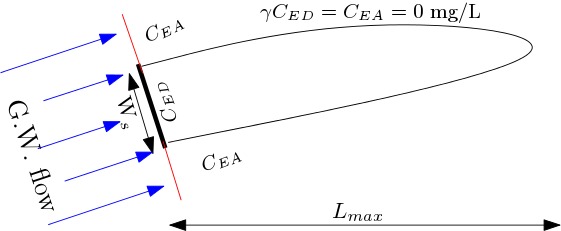Horizontal oriented 2D Model – Chu et al. (2004)¶
This model, based on Chu et al. (2004), provides an estimate of a steady-state plume length ($L_{max}$ ) and investigate the large-time solution behavior of a representative bioreactive transport model under the conditions that the mixing of two required substrate occurs only in the directions transverse to groundwater flow.

Chu et al.(2004) provides the following explicit expression for $L_{max}$:
$$ L_{max} = \frac{\pi}{16}\frac{W^2}{\alpha_{TH}}{\bigg(\frac{\gamma C_{ED}^\circ }{ C_{EA}^\circ - \epsilon }\bigg)^2} $$
in which:
$W$ = Width of contaminated source [L]
$\alpha_{TH}$ = Horizontal Transverse Dispersivity [L]
$\gamma$ = Reaction stoichiometric ratio [ ]
$C_{ED}^\circ$ = Contaminant (Electron Donor) concentration [ML$^{-1}$]
$C_{EA}^\circ$ = Partner Reactant (Electron Acceptor) concentration [ML$^{-1}$]
$\epsilon$ = Biological concentration factor [ML$^{-1}$].
The model is based on the following assumptions:
- There is a continuous line source of contamination and instantaneous reaction model.
- A dissolved contaminant is assumed to be biodegraded only at its plume fringe because of transverse mixing but not inside the plume.
Reference:
M. Chu P. K. Kitanidis P. L. McCarty. Modeling microbial reactions at the plume fringe subject to transverse mixing in porous media: When can the rates of microbial reaction be assumed to be instantaneous? https://doi.org/10.1029/2004WR003495